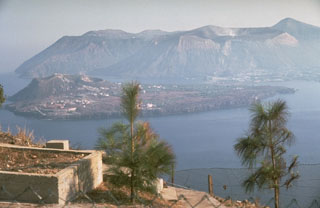Report on Vulcano (Italy) — March 1992
Bulletin of the Global Volcanism Network, vol. 17, no. 3 (March 1992)
Managing Editor: Lindsay McClelland.
Vulcano (Italy) Vigorous fumarolic activity
Please cite this report as:
Global Volcanism Program, 1992. Report on Vulcano (Italy) (McClelland, L., ed.). Bulletin of the Global Volcanism Network, 17:3. Smithsonian Institution. https://doi.org/10.5479/si.GVP.BGVN199203-211050
Vulcano
Italy
38.404°N, 14.962°E; summit elev. 500 m
All times are local (unless otherwise noted)
Vigorous fumarolic activity was continuing from the N rim of the historically active crater (Fossa Grande) and from thermal areas on the upper N flank during a visit on the afternoon of 18 March. Most of the fumaroles were concentrated along the N crater rim, inside the N part of the crater, and on the N flank of the wall of tephra built during Vulcano's last eruption, in 1888-90. The main fumarole field appears to have extended a short distance to the E along the N crater rim, where new vents had formed since Behncke's last visit in November 1990. A new linear zone of high-pressure gas emission has developed roughly parallel to the large fissure that formed after 1988 on the N crater wall. Fumarolic activity from scattered vents on the upper N flank seemed to have increased since November 1990, and a less-prominent thermal area on the outer SE flank included at least 7 weak fumarolic vents.
Intense hydrothermal alteration and erosional undercutting have occurred on the upper N flank, around the S rim of the 18th-century Forgia Vecchia craters. Extension cracks have appeared within a few meters of the steep N slope, and deep gullies extend toward the coastal town of Porto di Levante.
Geological Summary. The word volcano is derived from Vulcano stratovolcano in Italy's Aeolian Islands. Vulcano was constructed during six stages over the past 136,000 years. Two overlapping calderas, the 2.5-km-wide Caldera del Piano on the SE and the 4-km-wide Caldera della Fossa on the NW, were formed at about 100,000 and 24,000-15,000 years ago, respectively, and volcanism has migrated north over time. La Fossa cone, active throughout the Holocene and the location of most historical eruptions, occupies the 3-km-wide Caldera della Fossa at the NW end of the elongated 3 x 7 km island. The Vulcanello lava platform is a low, roughly circular peninsula on the northern tip of Vulcano that was formed as an island beginning more than 2,000 years ago and was connected to the main island in about 1550 CE. Vulcanello is capped by three pyroclastic cones and was active intermittently until the 16th century. Explosive activity took place at the Fossa cone from 1898 to 1900.
Information Contacts: B. Behncke, GEOMAR, Kiel.

